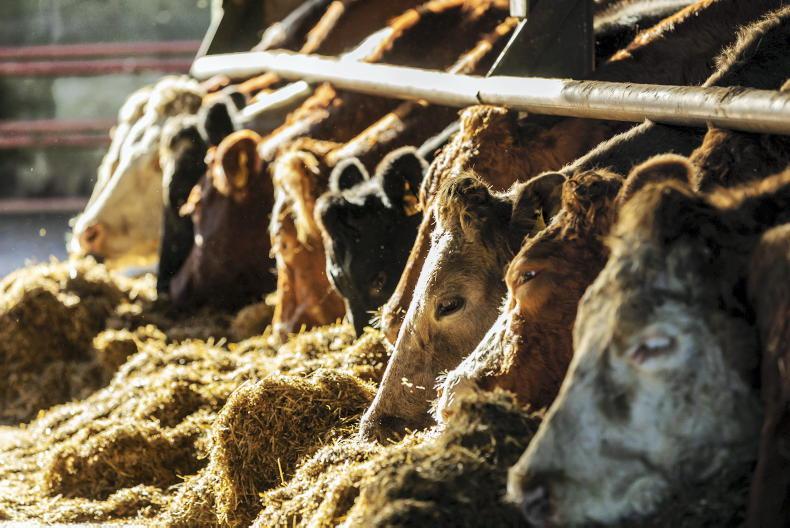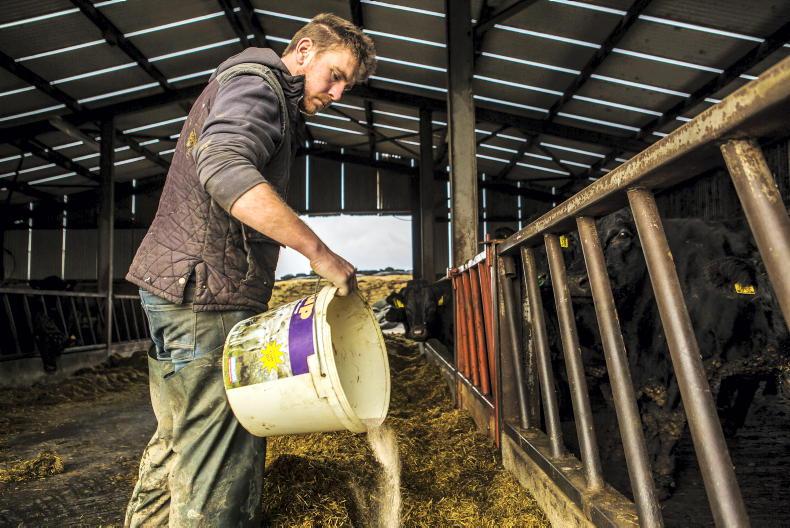There are variable reports coming to light regarding the threat of liver fluke disease. Areas of the country which have traditionally been categorised as high risk for liver fluke have a high probability of facing challenges in 2023, with reports of liver fluke starting to arise in slaughtered sheep.
The high risk area tends to cover large parts of Connacht and Ulster, with issues in the east and south likely to continue to be much more variable.
A parasite that is raising greater problems in the southeast in recent times is Haemonchus contortus – or, what is often known as “barber’s pole worm”. This is discussed in more detail later on in this article.
Liver fluke lifecycle
The lifecycle stage of the liver fluke parasite that presents the greatest challenge varies seasonally, and therefore, advice on treatment programmes and, in particular, product selection, also varies.
Liver fluke infestation in sheep can be categorised into three types – acute, sub-acute and chronic, as summarised in Table 1.
Acute fluke has traditionally posed the greatest risk in the period of August through to October. This categorisation is best characterised by grazing sheep ingesting high numbers of liver fluke parasites.
These parasites migrate to the liver and burrow through, causing great damage before reaching the bile ducts as adults up to 10 weeks later.
Depending on the severity, the damage caused to the liver can be fatal, leading to weakness, anaemia and sudden death. There are often no readily visible signs, with well-fleshed, apparently healthy animals with a high acute burden often collapsing and dying due to haemorrhaging of the liver.
This threat generally transitions to sub-acute fluke disease as you progress through to November. In such cases, there are growing numbers of immature and mature fluke present.
Losses can still occur due to acute fluke, but as you progress in to December and the New Year, the threat has mainly transitioned to chronic liver fluke.
Chronic liver fluke
Chronic liver fluke disease is easier to identify.
It is characterised by a prolonged period of liver fluke parasites causing damage, and typical signs include: weight loss, anaemia, and the so-called ‘bottle jaw’ appearance of sheep, whereby there is an accumulation of fluid under the animal’s jaw.
Diarrhoea is also sometimes seen.
Treatment options
There are six different flukicides available on the Republic and Northern Ireland market – namely Albendazole, Closantel, Nitroxynil, Oxyclozanide, Rafoxanide and Triclabendazole.
The advice when treating animals for liver fluke is, in general, to select a flukicide-only product that targets the stage of the liver fluke parasite present.
The rationale behind this advice is that there is no unnecessary or non-warranted treatment for mainly worms, and in turn, a reduced threat of increasing the rate of anthelmintic resistance developing.
A high percentage of combination products also only have a claim to treat mature liver fluke, which is not the concern at present. As such, the following advice and discussions regarding product selection will apply to flukicide-only products. This excludes albendazole-based products, which are combination only.
Ideally, a liver fluke treatmet programme will take account of all available information sources, including farm history, feedback from slaughtered or fallen animals, disease forecasts and veterinary advice.
Triclabendazole products, of which there are a handful available (Endofluke, Fasifree, Fasinex, Tribex and Triclaben), offer the most complete control, targeting early immature, immature and mature liver fluke.
It should be noted that for Triclabendazole to work, the molecule must be metabolised in a healthy liver. If the liver is damaged, then the product will not be able to work
The only standout aspect separating the products, according to the Health Products Regulatory Authority’s (HPRA) summary of product characteristics (SPC), is a slight difference in the withdrawal.
Resistance to Triclabendazole has been reported in some areas, and farmers who have any doubt about the efficacy of the product should be mindful of this and should investigate the issue with their vet.
It should be noted that for Triclabendazole to work, the molecule must be metabolised in a healthy liver.
If the liver is damaged, then the product will not be able to work and may give an impression that there is a resistance issue.
Closantel is the product that offers the next-best level of cover, just behind Triclabendazole. Again, there are numerous products, but the flukicide-only products are Flukiver and Solantel.
The HPRA’s SPC lists Flukiver 5% w/v oral suspension, possessing 86% efficacy against six-week-old fluke parasites.
A paper published in the proceedings of the Teagasc hill sheep conference in 2016 by Dr Barbara Good listed an efficacy figure of 23% to 73% for Closantel-based products against early immature fluke aged three and a half to five weeks.
It also listed that an increased efficacy is achieved at the higher dose rate (10mg/kg) recommended for the oral formulation.
The SPC for Solantel says the product is effective against mature and late immatures from five weeks upwards. The two products have the added benefit of also treating for Haemonchus contortus.
This makes the product a good option for farmers who have also identified issues on their farm with this parasite, which is relatively new to Ireland.
There are several fluke and worm combination products on the market containing the active ingredient Rafoxanide; the two individual products containing just Rafoxanide are Ridafluke and Ranide.
The SPC for Ridafluke lists up to 83% effectiveness against four-week-old immature fluke with this, dependent on the appropriate dose rate being administered.
The SPC for Ranide lists that it is active against mature and immature fluke over eight weeks of age. However, licence holders Univet claim a reported efficacy ranging from 45% to 98% against four-week old immature fluke, and 85% to 99% against six-week-old immature fluke.
‘Fascionix 34%’ is an injectable, Nitroxynil-based flukicide introduced to the market following the ending of Trodax being manufactured.
The product is similar to Trodax and targets mature and immature fluke. It remains on an emergency licence, and as such, there is no SPC listing in the HPRA database, or in the UK Veterinary Medicines Directory (VMD) for it.
Previous data related to Trodax and published by Teagasc reported 91% to 100% efficacy for fluke parasites aged 10 to 12 weeks, and 50% to 90% for immature fluke aged upwards of six weeks.
Interchem who are marketing Fascionix 34% state that the normal dose rate of 1ml/35kg bodyweight should be increased to 1.25ml/35kg for acute fasciolosis and targeting immature forms.
Other effects
The product is also effective against adult and larval forms of Haemonchus contortus (barber’s pole worm) in sheep and cattle.
There are a number of Oxyclozanide-based flukicides on the market for sheep, including Zanil, Distocur 34 and Oxyfluke 34.
The Teagasc paper lists the efficacy of Zanil as being 50% to 70% against mature fluke parasites aged 10 to 11 weeks, and 80% to 99% thereafter.
Meanwhile, unlicensed Oxyclozanide-based products have a role in the treatment of rumen fluke where there is a demonstrated need.
Levafasc Diamond Fluke and Worm Drench – no quick fix
A common combination product used by farmers, containing Oxyclozanide, is Levafasc Diamond Fluke and Worm Drench.
Farmers should note that this targets only mature liver fluke, with the product SPC reporting that it will remove “most” mature fluke parasites present in the bile duct. As such, strategic treatment is required, similar to products containing just Oxyclozanide.
What is Haemonchus contortus?
Haemonchus contortus or barber’s pole worm is a major issue in sheep in more temperate climates. It is increasing in frequency in the southeast in recent years, where it is causing big issues on individual farms.
The Department Regional Veterinary Laboratories have reported that adult worms can remove 0.05ml of blood per day. The parasite is prolific at reproducing and a worm count of 5,000 worms could be causing blood loss of 250ml daily.
Standard faecal egg count analysis does not identify Haemonchus, and as such, an unusually high worm count (can be anywhere from 5,000 to 20,000 plus) should raise alarm bells of potential issues.
The parasite is prolific at reproducing and a worm count of 5,000 worms could be causing blood loss of 250ml daily
Typical signs of infestation include: paleness of gums and conjunctivae, swelling under the jaw similar to bottle jaw, increased rate and depth of breathing, and an increased heart rate.
Clinical signs can also include sudden deaths in very acute cases and ill-thrift in chronic cases. Diarrhoea is not a typical feature of the disease.
Farmers are urged to contact their vet if they suspect issues in their flock. It is also worth carrying out periodic faecal egg counts in ewes to monitor worm burdens.
There are variable reports coming to light regarding the threat of liver fluke disease. Areas of the country which have traditionally been categorised as high risk for liver fluke have a high probability of facing challenges in 2023, with reports of liver fluke starting to arise in slaughtered sheep.
The high risk area tends to cover large parts of Connacht and Ulster, with issues in the east and south likely to continue to be much more variable.
A parasite that is raising greater problems in the southeast in recent times is Haemonchus contortus – or, what is often known as “barber’s pole worm”. This is discussed in more detail later on in this article.
Liver fluke lifecycle
The lifecycle stage of the liver fluke parasite that presents the greatest challenge varies seasonally, and therefore, advice on treatment programmes and, in particular, product selection, also varies.
Liver fluke infestation in sheep can be categorised into three types – acute, sub-acute and chronic, as summarised in Table 1.
Acute fluke has traditionally posed the greatest risk in the period of August through to October. This categorisation is best characterised by grazing sheep ingesting high numbers of liver fluke parasites.
These parasites migrate to the liver and burrow through, causing great damage before reaching the bile ducts as adults up to 10 weeks later.
Depending on the severity, the damage caused to the liver can be fatal, leading to weakness, anaemia and sudden death. There are often no readily visible signs, with well-fleshed, apparently healthy animals with a high acute burden often collapsing and dying due to haemorrhaging of the liver.
This threat generally transitions to sub-acute fluke disease as you progress through to November. In such cases, there are growing numbers of immature and mature fluke present.
Losses can still occur due to acute fluke, but as you progress in to December and the New Year, the threat has mainly transitioned to chronic liver fluke.
Chronic liver fluke
Chronic liver fluke disease is easier to identify.
It is characterised by a prolonged period of liver fluke parasites causing damage, and typical signs include: weight loss, anaemia, and the so-called ‘bottle jaw’ appearance of sheep, whereby there is an accumulation of fluid under the animal’s jaw.
Diarrhoea is also sometimes seen.
Treatment options
There are six different flukicides available on the Republic and Northern Ireland market – namely Albendazole, Closantel, Nitroxynil, Oxyclozanide, Rafoxanide and Triclabendazole.
The advice when treating animals for liver fluke is, in general, to select a flukicide-only product that targets the stage of the liver fluke parasite present.
The rationale behind this advice is that there is no unnecessary or non-warranted treatment for mainly worms, and in turn, a reduced threat of increasing the rate of anthelmintic resistance developing.
A high percentage of combination products also only have a claim to treat mature liver fluke, which is not the concern at present. As such, the following advice and discussions regarding product selection will apply to flukicide-only products. This excludes albendazole-based products, which are combination only.
Ideally, a liver fluke treatmet programme will take account of all available information sources, including farm history, feedback from slaughtered or fallen animals, disease forecasts and veterinary advice.
Triclabendazole products, of which there are a handful available (Endofluke, Fasifree, Fasinex, Tribex and Triclaben), offer the most complete control, targeting early immature, immature and mature liver fluke.
It should be noted that for Triclabendazole to work, the molecule must be metabolised in a healthy liver. If the liver is damaged, then the product will not be able to work
The only standout aspect separating the products, according to the Health Products Regulatory Authority’s (HPRA) summary of product characteristics (SPC), is a slight difference in the withdrawal.
Resistance to Triclabendazole has been reported in some areas, and farmers who have any doubt about the efficacy of the product should be mindful of this and should investigate the issue with their vet.
It should be noted that for Triclabendazole to work, the molecule must be metabolised in a healthy liver.
If the liver is damaged, then the product will not be able to work and may give an impression that there is a resistance issue.
Closantel is the product that offers the next-best level of cover, just behind Triclabendazole. Again, there are numerous products, but the flukicide-only products are Flukiver and Solantel.
The HPRA’s SPC lists Flukiver 5% w/v oral suspension, possessing 86% efficacy against six-week-old fluke parasites.
A paper published in the proceedings of the Teagasc hill sheep conference in 2016 by Dr Barbara Good listed an efficacy figure of 23% to 73% for Closantel-based products against early immature fluke aged three and a half to five weeks.
It also listed that an increased efficacy is achieved at the higher dose rate (10mg/kg) recommended for the oral formulation.
The SPC for Solantel says the product is effective against mature and late immatures from five weeks upwards. The two products have the added benefit of also treating for Haemonchus contortus.
This makes the product a good option for farmers who have also identified issues on their farm with this parasite, which is relatively new to Ireland.
There are several fluke and worm combination products on the market containing the active ingredient Rafoxanide; the two individual products containing just Rafoxanide are Ridafluke and Ranide.
The SPC for Ridafluke lists up to 83% effectiveness against four-week-old immature fluke with this, dependent on the appropriate dose rate being administered.
The SPC for Ranide lists that it is active against mature and immature fluke over eight weeks of age. However, licence holders Univet claim a reported efficacy ranging from 45% to 98% against four-week old immature fluke, and 85% to 99% against six-week-old immature fluke.
‘Fascionix 34%’ is an injectable, Nitroxynil-based flukicide introduced to the market following the ending of Trodax being manufactured.
The product is similar to Trodax and targets mature and immature fluke. It remains on an emergency licence, and as such, there is no SPC listing in the HPRA database, or in the UK Veterinary Medicines Directory (VMD) for it.
Previous data related to Trodax and published by Teagasc reported 91% to 100% efficacy for fluke parasites aged 10 to 12 weeks, and 50% to 90% for immature fluke aged upwards of six weeks.
Interchem who are marketing Fascionix 34% state that the normal dose rate of 1ml/35kg bodyweight should be increased to 1.25ml/35kg for acute fasciolosis and targeting immature forms.
Other effects
The product is also effective against adult and larval forms of Haemonchus contortus (barber’s pole worm) in sheep and cattle.
There are a number of Oxyclozanide-based flukicides on the market for sheep, including Zanil, Distocur 34 and Oxyfluke 34.
The Teagasc paper lists the efficacy of Zanil as being 50% to 70% against mature fluke parasites aged 10 to 11 weeks, and 80% to 99% thereafter.
Meanwhile, unlicensed Oxyclozanide-based products have a role in the treatment of rumen fluke where there is a demonstrated need.
Levafasc Diamond Fluke and Worm Drench – no quick fix
A common combination product used by farmers, containing Oxyclozanide, is Levafasc Diamond Fluke and Worm Drench.
Farmers should note that this targets only mature liver fluke, with the product SPC reporting that it will remove “most” mature fluke parasites present in the bile duct. As such, strategic treatment is required, similar to products containing just Oxyclozanide.
What is Haemonchus contortus?
Haemonchus contortus or barber’s pole worm is a major issue in sheep in more temperate climates. It is increasing in frequency in the southeast in recent years, where it is causing big issues on individual farms.
The Department Regional Veterinary Laboratories have reported that adult worms can remove 0.05ml of blood per day. The parasite is prolific at reproducing and a worm count of 5,000 worms could be causing blood loss of 250ml daily.
Standard faecal egg count analysis does not identify Haemonchus, and as such, an unusually high worm count (can be anywhere from 5,000 to 20,000 plus) should raise alarm bells of potential issues.
The parasite is prolific at reproducing and a worm count of 5,000 worms could be causing blood loss of 250ml daily
Typical signs of infestation include: paleness of gums and conjunctivae, swelling under the jaw similar to bottle jaw, increased rate and depth of breathing, and an increased heart rate.
Clinical signs can also include sudden deaths in very acute cases and ill-thrift in chronic cases. Diarrhoea is not a typical feature of the disease.
Farmers are urged to contact their vet if they suspect issues in their flock. It is also worth carrying out periodic faecal egg counts in ewes to monitor worm burdens.










SHARING OPTIONS